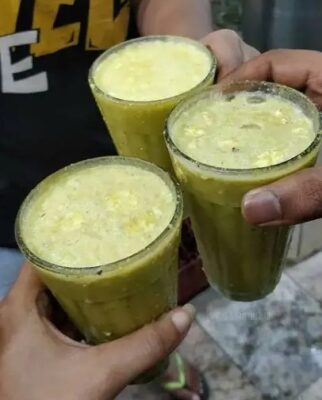Uncategorized
What is Bhang?
People can consume marijuana in many ways, including smoking it in a joint or bong, eating it, or using it in concentrated forms like lotions and transdermal patches.
There will always be more methods to use marijuana, even though it’s been legal for a long time. We’ve all heard about vaporizers and other new innovative stoner gadgets, but they’re not the only ways to take cannabis. We’ve all heard about vaporizers and other new amazing stoner equipment, but this isn’t to imply that previous techniques are unimportant.
Some of the most traditional methods for consuming marijuana are still widely used today. This includes joints, pipes, and bongs, as well as different forms of edibles. All these ways to consume marijuana date back thousands and thousands of years ago.
For example, bhang is another age-old way to consume marijuana that people still use today, although not as frequently. Let’s learn more about bhang and how it’s made.
What Is Bhang and Where Does It Come From?
 Bhang is a type of cannabis beverage from the Indian Subcontinent (Bangladesh, Bhutan, India, Maldives, Nepal, Pakistan Sri Lanka) that has been consumed for thousands of years. It dates back at least 1000 B.C. in Ancient India.
Bhang is a type of cannabis beverage from the Indian Subcontinent (Bangladesh, Bhutan, India, Maldives, Nepal, Pakistan Sri Lanka) that has been consumed for thousands of years. It dates back at least 1000 B.C. in Ancient India.
Bhang is a drink that normally contains milk or yogurt, spices, and a paste made from cannabis leaves and flowers. Cannabis is taken from female marijuana plants, which are also known as the ones that produce buds.
According to the sacred Hindu scripture Atharvaveda, cannabis is one of the five most divine plants. They would burn cannabis stems and use it as yagna, a ceremonial fire ritual designed to drive away evil forces and enemies.
While growing and selling marijuana is expressly forbidden in India, Bhang is permitted in certain regions because of their cultural and religious beliefs. The Indian National Policy on Narcotics and Psychotropic Substances, however, only allows for cannabis plant leaves to be used in the mix.
Bhang and the Hindu Culture
Bhang is adored by Hindu culture since it has ties to Shiva, the god of destruction and transformation. While this may appear harsh, in Hinduism, as destroyed, rather than a bad thing, it is because it leads to new creation and fresh life in Hinduism.
The Hindu deity Shiva is said to have given bhang as a present with the claim that he used it himself to enhance his abilities.
According to the sacred Hindu scripture Atharvaveda, cannabis is one of the five most divine plants. They would burn cannabis stems and use it as yagna, a ceremonial fire ritual designed to drive away evil forces and enemies.
Bhang has been used in India for centuries and is so prevalent that when British colonizers arrived and saw it, they decided outlawing it would cause too much social unrest.
What Are Bhang’s Uses?
Marijuana is consumed for a variety of reasons in medicine, therapy, and religion. Bhang has long been used as a source for both medical and spiritual purposes in Indian culture. Bhang aids in the relaxation of muscles and allows people to embrace new possibilities and viewpoints.
 Moreover, ancient Indian forms of medicine such as Tibbi and Ayurveda used cannabis medicinally to treat illnesses like malaria and rheumatism. For instance, in more rural areas of India, the locals believe that bhang has curative properties for fevers, sunstroke and dysentery; it is also known to aid digestion & alleviate impediments in speech.
Moreover, ancient Indian forms of medicine such as Tibbi and Ayurveda used cannabis medicinally to treat illnesses like malaria and rheumatism. For instance, in more rural areas of India, the locals believe that bhang has curative properties for fevers, sunstroke and dysentery; it is also known to aid digestion & alleviate impediments in speech.
Bhang was also used as a paste, which warriors would apply while making their decisions and relaxing their nerves. Newlywed couples took full advantage of the opportunity to use it as a natural aphrodisiac to enhance their sex drive.
Research has found that THC, the main psychoactive compound in marijuana, can help reduce chemotherapy-induced nausea and vomiting in cancer patients.
Marijuana, like bhang, may be consumed as an oral variety of medical marijuana for pain alleviation due to its powerful analgesic and anti-inflammatory properties. Anti-seizure activity Edibles provide a stronger body high than smoking or vaporizing cannabis, making bhang perfect for people with issues such as multiple sclerosis or epilepsy. Marijuana’s cancer-preventing effects have been well established. Smoking marijuana produces delta-9-tetrahydrocannabinol (THC), a powerful psychotropic chemical that induces sleep and is used to treat sleeping disorders. Furthermore, due to medical therapies, the THC in marijuana often leads to decreased appetite.
Now that we are aware of some of the benefits bhang has to offer, it is time to learn how to make it!
How To Make Bhang
Bhang is a popular marijuana derivative in Nepal, produced by combining cannabis with water, curd and whey (the solid and liquid components of milk that get separated when you coagulate milk).
It can also be made from mixing the drug with a variety of spices.
If you’re a cultivator yourself, definitely do use your fan leaves and trims. Freshly cut marijuana works much better than already dried flowers and leaves.
If you’re interested in making bhang at home, here’s an easy recipe for you to follow.
Ingredients and Tools
- 2 cups of water;
- 14 grams of fresh cannabis leaves and flowers;
- 3 cups of warm milk;
- 1/2 cup honey or sugar;
- 1/4 tsp ground ginger;
- 1/4 tsp garam masala;
- 1/2 tsp ground anise;
- 1/2 tsp ground cardamom;
- 1/4 tsp ground fennel;
- 1/2 tsp rosewater;
- Mint leaves, rose petals, crushed almonds, or pistachios to garnish;
- 1 large saucepan with lid;
- 1 container;
- Mortar and pestle;
- And a fine mesh strainer or cheesecloth.
After you assemble your tools and ingredients, you can begin cooking bhang.
Instructions to Make Bhang Thandai
 Making bhang is easy and only requires 5 simple steps. So put on your apron and head to the kitchen for a delicious treat.
Making bhang is easy and only requires 5 simple steps. So put on your apron and head to the kitchen for a delicious treat.
Step 1
Prepare the water in two cups and then, after it has boiled, add it to the pan. Bring the temperature of the pot back up to a simmer and then add the weed plant material. 7 minutes later, turn off the heat and let everything steep together for a while before serving with salsa or kimchi on top.
Step 2
Take the cheesecloth or fine mesh strainer, and drain your leaves and flowers from the water into a container to the side. Squeeze the plant material until all of the liquid has been removed.
Step 3
To start, take the plant waste and mix it with 2 teaspoons of warm milk using a mortar and pestle. Once you’ve ground the mixture to completion, gently squeeze the leaves and flowers one last time before getting rid of them. The leftover milk should be saved for later use.
Repeat until you’ve used 1/2 cup of milk.
Step 4
To make a more nourishing milk, take the garnish of choice, mint, almonds, or pistachios and combine them with some further warm milk in the mortar and pestle. Continue to process until a fine paste forms. Combine the extract once again with the other liquids and discard any remaining nut fibers or byproducts.
Step 5
In a medium bowl, mix together the ginger, anise, garam masala, fennel, cardamom and rosewater. Add in the honey and rest of warm milk as well.
Bhang is a cannabis-based drink originating in India.
Simply transfer the prepared smoothie into a glass, give it a good stir, then drink up!
In Conclusion
Improve your stoner experiences by simply being curious and investigating different options!
Researching about interests provides opportunities to discover more information and learn in-depth details that couldn’t be found otherwise. For example, Cannabis can be a difficult topic to fully understand without first conducting some sort of investigation.
Break out of your comfort zone! The world has so much to offer, and there’s no need to stay stuck in one place. Trying new things is how we grow and learn, and the cannabis field is a great example. There’s more to explore than the standard joint or bong – so what are you waiting for?



